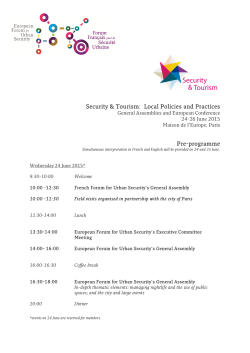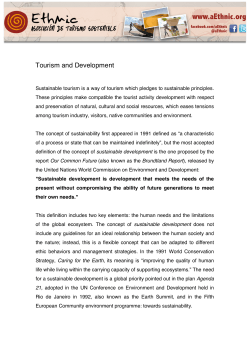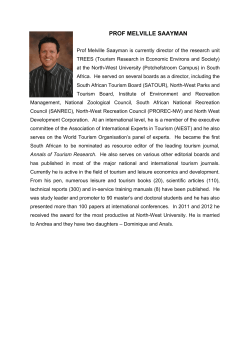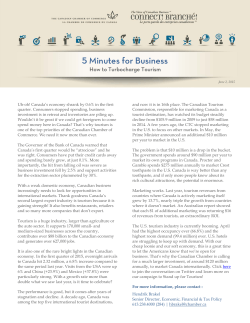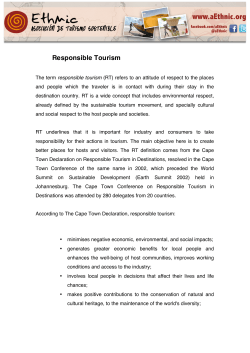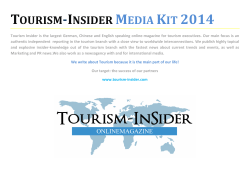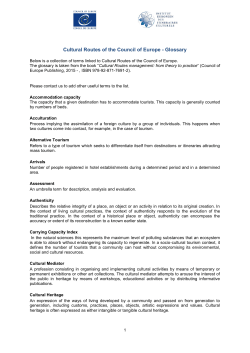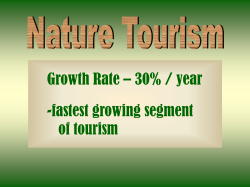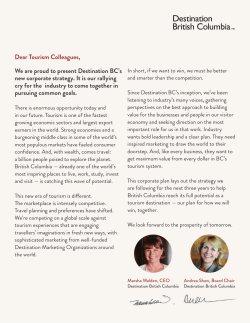
Mimisbrunnr Climate Park – a network for heritage learning, tourism
Journal of Heritage Tourism ISSN: 1743-873X (Print) 1747-6631 (Online) Journal homepage: http://www.tandfonline.com/loi/rjht20 Mimisbrunnr Climate Park – a network for heritage learning, tourism development, and climate consciousness Odd Inge Vistad, Line Camilla Wold, Karoline Daugstad & Jan Vidar Haukeland To cite this article: Odd Inge Vistad, Line Camilla Wold, Karoline Daugstad & Jan Vidar Haukeland (2015): Mimisbrunnr Climate Park – a network for heritage learning, tourism development, and climate consciousness, Journal of Heritage Tourism, DOI: 10.1080/1743873X.2015.1082570 To link to this article: http://dx.doi.org/10.1080/1743873X.2015.1082570 Published online: 18 Sep 2015. Submit your article to this journal View related articles View Crossmark data Full Terms & Conditions of access and use can be found at http://www.tandfonline.com/action/journalInformation?journalCode=rjht20 Download by: [Norsk Institutt for Naturforskning] Date: 19 September 2015, At: 12:27 Journal of Heritage Tourism, 2015 http://dx.doi.org/10.1080/1743873X.2015.1082570 Mimisbrunnr Climate Park – a network for heritage learning, tourism development, and climate consciousness Odd Inge Vistada*, Line Camilla Wolda, Karoline Daugstadb and Jan Vidar Haukelandc,d Downloaded by [Norsk Institutt for Naturforskning] at 12:27 19 September 2015 a Human Dimension Department, Norwegian Institute for Nature Research – NINA, Fakkelgården, NO-2624 Lillehammer, Norway; bDepartment of Geography, NTNU, Trondheim, Norway; c Department of Ecology and Natural Resource Management, NMBU, Ås, Norway; dInstitute of Transport Economics, TØI, Oslo, Norway (Received 24 January 2015; accepted 1 June 2015) Increased ice melting revealed in 2006–2007 many reminiscences of ancient human activity around ice patches near Mt Galdhøpiggen, Norway’s highest mountain peak. The public limited company “Klimapark 2469 AS” was established to develop a heritage interpretation product and to study climate change. A 60-metre long ice tunnel is excavated in the ice patch Juvfonna, where guided walks and a display presenting climate change, archeology, Norse mythology, and glaciology are offered. The heritage product, “Mimisbrunnr Climate Park 2469” (MK2469), is based on collaboration between scientific institutions, public authorities, the National Mountain Museum, and private tourist companies. The ambition is to combine science, environmental learning, interpretation, heritage tourism, and local development. Based on interviews and relevant documents, we have studied the network – the actors, their ambitions, and networking processes: What are the perceived opportunities, challenges, outcomes, and success factors? Good strategic work has resulted in extensive public funding and sponsorship, and MK2469 has become a diverse, quality heritage product, but so far with little commercial success. An important outcome is the fruitful exchange of experiences, between public and private partners, tourism and science interests, amateurs and professionals, and between local, regional and national actors. The network has shown to be quite dynamic. Keywords: heritage tourism: climate change; collaboration; resource management; local development; Norway Introduction The Climate Park network was initiated in the wake of increased ice melting due to climate change, when reminiscences of ancient human activity were revealed around glaciers and ice patches in the mountains of Oppland County, Norway. When ice patches shrink a number of remnants reappear. The findings around Juvfonna and other ice patches have been of special interest: A leather shoe, a knitted tunic (Vedeler & Jørgensen, 2013), and tools used for reindeer hunting in the Bronze Age (Nesje et al., 2012). Juvfonna is located below Galdhøpiggen, the highest mountain peak in Norway (2469 m), and very close to the border of Jotunheimen National Park. The speed of the ice melting is formidable *Corresponding author. Email: odd.inge.vistad@nina.no © 2015 Taylor & Francis Downloaded by [Norsk Institutt for Naturforskning] at 12:27 19 September 2015 2 O.I. Vistad et al. and alarming, but the number of new archaeological objects give a unique possibility for improving the knowledge and for interpreting the story about the early inhabitants and users of these mountain areas. The public limited company “Klimapark 2469 AS” was established to give a formal base for a broad and more informal network called “Mimisbrunnr Klimapark 2469” (MK2469) and for the heritage product with the same name. Mimisbrunnr is Old Norse and means Mimir’s well, and Klimapark means Climate Park. The ambition was to study climate change “on site” and to interpret natural and cultural heritage to a broad audience. The main attraction in MK2469 is a 60-metre long ice tunnel excavated with an ice axe in Juvfonna, all the way to the bottom of the ice patch where the ice is 6000 years old. There is a display combined with personal guiding in the tunnel focussing on natural history, glaciology, archaeology, Norse mythology, and climate change. The name of the Climate Park needs an explanation, and we quote from the homepage (www.mimisbrunnr.no): “In Norse mythology, Mímisbrunnr was a well of knowledge and wisdom by the roots of Yggdrasil, the World Tree, in Jotunheimen. The source, or well, was guarded by Mime (Mímir) – the wisest giant of all.” Odin (the All-father among gods, in Norse mythology) sacrificed an eye to the well to get to drink from it and thereby grow wiser. As a heritage tourism product, MK2469 is quite complex: visitors are encouraged to start with an introduction and the exhibition “Out of the ice” at the Norwegian Mountain Museum in the municipal centre of Lom. The MK2469, with the ice tunnel is located a 45 minute drive away from this centre, at Juvflya. There a guided walk is carried out along a carefully constructed 1100 metre-long boardwalk over the scree and permafrost area, until the ice front. The guided walk in the 60-metre long ice tunnel is the main attraction. The boardwalk is free for use by anyone, but the tunnel is only open to guided groups. The main season is from late June to late in August, and the visitor numbers were 2500 in 2012, 4000 in 2013, and 3400 in 2014. As well as regular groups of tourists and locals, visitors included pre-ordered groups with regional school classes (free of charge), students, and expert groups. August 2013 the MK2469 heritage product was expanded with an outdoor opera. The Volve (a female soothsayer and interpreter of religion) performed “The voice from Mimisbrunnr” at the cirque glacier Kjelbreen, only a few hundred metres from the ice tunnel. New music was written (and pre-recorded), and the libretto was based on the poem Voluspå (meaning the prophecy of the Volve) from Norse mythology. The poem describes the world history from the creation until doomsday. The Klimapark-company is a key element in the broader MK2469-network, comprising various actors representing science, interpretation, education, resource management, and tourism development. The main objective for the company even shows the ambition for the MK2469-network (see www.mimisbrunnr.no): Klimapark 2469 AS shall, through attractions developed in collaboration with professional contributors and aimed at a wide audience, communicate interactive experiences of, and insight into, current climate processes and the interaction between nature and humans seen in a long-term perspective. The purpose of such communication and experiences is to promote interest as well as understanding in terms of thematics, and to create increased levels of value and innovation. Main arenas are the park at Juvflye by the foot of Galdhøpiggen, and the Norwegian Mountain Museum. In this paper, we take a broad approach to heritage and heritage tourism, including both cultural and natural heritage, and where resource management, science, knowledge, interpretation, and development of attractions and local economy are relevant and integrated elements (e.g. Timothy & Boyd, 2006). This is a common background when studying Journal of Heritage Tourism 3 Downloaded by [Norsk Institutt for Naturforskning] at 12:27 19 September 2015 networks related to tourism, resource protection, and interpretation (Albrecht, 2013; McCool, 2009). More specifically, we intend to analyse the MK2469-network, as a new and promising example of collaboration, and raise the following research questions: (1) What do the participating partners/sectors regard as the outcomes – from the process leading to the establishment of the MK2469-network as well as from the operating network? (2) What are the challenges and opportunities for the local tourism sector and development of the local community Lom? (3) What are the perceived success factors/challenges concerning environmental consciousness, heritage interpretation and heritage tourism? We base our work on two theoretical perspectives: (1) the network and collaboration literature relevant for linking tourism development with resource management and community development and (2) the concepts of heritage tourism, heritage protection, and environmental education. Our ambition is to integrate these two perspectives, since the Mimisbrunnr Klimapark-network seems to have the potential to bring up new and relevant experiences through collaboration in relation to both perspectives. Networks and collaboration Tourism has always been a networking industry, where hotels, attractions, transport, and tourism offices have collaborated, formally or informally (Scott, Baggio, & Cooper, 2008). The aim of this paper is to study networking in a broader sense. Albrecht (2013) concludes that even if substantial progress is made in the investigation of private sector networks at the destination levels, “research on networks involving public sector stakeholders and networks across sectors and levels of governance, however, remains limited” (p. 639). Albrecht (2013), states that there is no generally accepted definition of “network”. Hall (2011) though, distinguishes between four different governance typologies and discusses also the “network” variety, but concludes more or less like Scott et al. (2008) that network governance is the “third way”, between market governance and hierarchical governance (the “traditional” top-down state governance model). According to Hall (2011), networks have been proposed as means to integrate different perspectives. Scott et al. (2008) link the concepts of networks, collaboration and trust, and refer to Jamal and Getz’s (1995) application of collaboration theory to tourism destinations. Jamal and Getz (1995) base much of their concepts and approach on Gray’s (1989) seminal work on collaboration, and define stakeholders as actors with an interest in a common problem or issue, that are influenced by the actions others take concerning this common issue. Therefore, collaboration can be an effective way to advance shared visions, where actors or stakeholders see the potential value of working together. Others are more concerned about systemic constraints in collaboration work and question whether all the relevant stakeholders are participating or invited into an inclusionary collaboration and whether the person representing the stakeholder is truly representative (Bramwell & Sharman, 1999). Dredge (2006) also notes that immediate success might be temporary, since stakeholders have a tendency to suppress their own interests in the initial phase. Our study concerns a new type of collaboration in Norwegian tourism development where very different actors, such as government agencies, both public and private sector, private enterprises, and scientists establish a network. Thus, as Jamal and Getz (1995) Downloaded by [Norsk Institutt for Naturforskning] at 12:27 19 September 2015 4 O.I. Vistad et al. point out, a networking process will often be a challenging task that requires development of new mechanisms and processes for incorporating the diverse elements into the tourism system. A good facilitator can make an important contribution and even play a crucial role. The facilitator might be an “outsider” since the outsider is sometimes considered to have fewer stakes and is therefore more credible for the whole network (Bramwell & Sharman, 1999). Clusters of small and medium enterprises can play a key role in tourism development. However, Novelli, Schmitz, and Spencer (2006) found that the process itself is critical, and network development must not be seen as a simple and spontaneous event: “The most relevant outcome of the empirical work was given by the fact that collaboration between local authorities and supporting bodies, education and research institutions and local SMEs is a key factor” (p. 1151). Heritage protection, interpretation and heritage tourism To balance the protection of natural and cultural heritage and visitation and experience of the same heritage has been an issue and a challenge for decades. For example, Hall (2010) discusses tourism as a factor in the continuing decline of biodiversity, and the need for research and increased knowledge regarding the mechanisms at play. The use-protection issue has been approached in many ways, and national policies vary, especially concerning, for example, the position of tourism in protected areas (Higham & Vistad, 2011). The challenges or tensions have often been strengthened due to a lack of societal agreement about goals for the management of these resources and areas (McCool, 2009). Norway (and its neighbour Sweden) have probably been among the most restrictive countries, when it comes to stimulating tourism in protected areas and national parks. This policy line can largely be ascribed to a dominating biological hegemony in nature management in these countries (Haukeland, Daugstad, & Vistad, 2011; Higham & Vistad, 2011; Stenseke & Hansen, 2014). However, a national branding strategy for promoting visitation in Norwegian national parks has recently been approved. Moreover, environmental learning and interpretation, for example, through national park centres have become increasingly important during the last 20 years (Ministry of Environment, 1992). Interpretation, heritage learning, and educational or heritage tourism are all receiving positive attention, in part due to the potential for educating and influencing people at a time when environmental knowledge and concern are needed, but also to strengthen economic development in more remote areas (Timothy & Boyd, 2006). Ho and McKercher (2004) discuss the difference between the theoretical level of treating cultural heritage as a tourism product – being a logic and obvious thing – and the practical level where it is much more complicated, since tourism and cultural heritage management embrace different management mandates and focuses. For example, Davis (1989, p. 96), an American archaeologist stated: “Is an archaeological site important to science or to the public, and is there a difference?” This is not only a rhetorical question, and she gives a complex answer. One of her points is that there are sites which are primarily scientific and where the public would not be interested, “but I also believe that if there is significant scientific information in a site, then the public should be told about it. The significance lies in the associational context of the material culture … ” (p. 97). In their work from Australia on critical commercial success factors in heritage tourism, Hughes and Carlsen (2010) identified nine critical factors. They point at the literature indicating tension between authenticity and the commercial focus; being commercial undermines authenticity, might degrade its quality and thereby its quality as a tourism product. Journal of Heritage Tourism 5 However, their research says quite the opposite; heritage tourism products with the highest commercial success also have a high score on authenticity and quality of the product and experiences. Alternatively, also those with good governmental resource backing were successful. The other critical success factors are: agreed objectives and clear concepts, effective marketing based on market research and knowledge on visitor flows, good human resource management of the staff, planning for product differentiation, to engage cultural heritage and tourism expertise in conservation and promotion, and interpretation as an integral part of the heritage experience. Downloaded by [Norsk Institutt for Naturforskning] at 12:27 19 September 2015 The case study area: Lom and Jotunheimen – a long history within (heritage) tourism Lom and the Jotunheimen area can be labelled as the most important mountain tourism destination in Norway, and has been so since the mid-nineteenth century. Jotunheimen is the most alpine mountain area in Norway, with the highest peaks. The natural qualities, the wild character, and the steep mountains made it a cradle for both geography and natural science disciplines, and for mountaineering and tourism in Norway, and the area had an obvious position in the picture of “the pure and authentic Norway” and in national romantic arts like painting, poetry, and music. British sportsman and mountaineer Slingsby (1904) was among the pioneers – both a glacier and a peak in Jotunheimen are named after him – and he is regarded as the father of mountaineering in Norway. His first expedition to Norway and to Jotunheimen was in 1872. Against this background, there were good reasons to locate the Norwegian Mountain Museum in Lom; it opened in 1994 and the focus is on “ … the relations between humans and the mountains” (http://fjell.museum. no/english/). Since 1997, it has also been the official Jotunheimen National Park centre. In 1980, Jotunheimen National Park was established. A Norwegian National Park is, by definition (section 35 in The Nature Diversity Act), an area without infrastructure for motorized vehicles, and without modern tourism facilities. That is probably the reason why the Juvflya-area, where MK2469 is located, was left outside the national park border of Jotunheimen National Park; Juvflya holds both the mountain hotel Juvasshytta and a paved road, namely the highest located road in northern Europe. A visitor strategy for Jotunheimen National Park has been approved (Forvaltningsstyret for Jotunheimen, 2012), where the Juvflya-area is designated as one of seven entrance points of national importance around the National Park. “New” tourism activities within national parks must anyhow adapt to the legally embedded policy of non-motorized visitation. In Jotunheimen National Park, “new” very much means to keep up and develop the more than 150 year tradition with mountain tourism. In general, there is little tradition in Norway of formalized collaboration between the private tourism sector and national park management. There are statements, especially from tourism actors, that public management authorities do not acknowledge the position and needs of the tourism sector operating in and around protected natural areas (Haukeland et al., 2011). Turning to the tourism activity in Lom municipality, the family businesses were, and still are, typical for tourism enterprises in Lom. The initial quite simple tourism offer “bed and food”, moved on to a broader hospitality product, but was quite early expanded to local guiding and mountaineering. This activity-, experience- and adventure-based product has dominated the mountain-based tourism in Lom over the past few decades. Lately, tourism in Lom has successfully expanded with a culinary focus based on local food traditions and with the use of wild ingredients as well as local farming products. The most famous and accessible cultural heritage attraction in Lom is the stave church, which is actually the neighbour building to the Norwegian Mountain Museum. The number 6 O.I. Vistad et al. of visits in the church has decreased radically since the mid-1990s, from around 65,000 annual visitors to 30,000 in 2013. In a local context, 30,000 is a high number, but these visitors are mainly coach tourists with short stays that bring little economic gains to Lom. Moreover, Lom is also a transit area for many motor tourists on their route to and from the fjord district of Western Norway. The destination and community therefore strive to establish new attractions in accordance with the long established image of tradition and authenticity, and encourage visitors to remain in the area an extra day. Downloaded by [Norsk Institutt for Naturforskning] at 12:27 19 September 2015 Methods This paper is based on a case study tied to the development and implementation of the Mimisbrunnr Klimapark 2469 network. The fieldwork was carried out during 2013. Our main data sources are in depth interviews with representatives from all the different categories of private and public partners in the network. Our 11 informants represent the following institutions: The Oppland county authority, Lom municipality, the local national park management, the Norwegian Mountain Museum, and the company “Klimapark 2469 AS”, tourism enterprises (three different operators), one of the scientific actors, and the destination company Jotunheimen reiseliv. One to three researchers participated in each interview. When two or more took part, one had the leading role while the other(-s) supplemented with follow-up questions. We used an interview guide covering the following broad topics: the initiative and initial phase of establishment of the collaboration, the following phases of developing the product and the network, collaboration and involvement among different actors and their respective roles, experienced outcome and challenges, sustainability in terms of both social environment, local community and nature/environment. In addition, background information about the informants and the institution they represented was also addressed. In total we conducted 10 interviews (with totally 11 informants, since one interview included two informants), seven face-to-face and three by phone. Interview lengths varied from 40 minutes to 1 hour and 40 minutes – the average being 70 minutes. With the informants’ consent, we recorded all interviews. Audiotapes were later carefully gone through and partly transcribed. That is, one of the researchers carefully drew notes when listening through the interviews and in addition quoted down especially illustrative and important utterances. We also studied the process of establishing MK2469 through document analysis, for example, minutes from board meetings in Klimapark 2469 AS, annual reports, agreements and relevant documents from homepages for the different collaborating partners. The transcripts and notes together with relevant documents were subject to a qualitative analysis where text sections were coded in repeated rounds of what Hesse-Biber and Leavy (2011) call “data reduction” or condensation. The initial codes or “tags” where mostly descriptive and directly drawn from the transcripts and in later rounds increasingly theoretically informed (Crang & Cook, 2007; Hesse-Biber & Leavy, 2011). At the MK2469 homepage (www.mimisbrunnr.no) all the partners and also the persons representing the partners are presented by name. In this paper, we will not use names, but often whom the informants represent and their formal position. Findings and discussion As presented, the company Klimapark 2469 AS has three formal owners, but include a much broader and varied spectrum of institutions in the MK2469-network. The owners underline that the network probably has not reached its final form or set of participants. Downloaded by [Norsk Institutt for Naturforskning] at 12:27 19 September 2015 Journal of Heritage Tourism 7 Mimisbrunnr Klimapark 2469 network – the idea, the establishing process and the actors The idea behind this trans-disciplinary collaboration in the high mountains of Oppland came from the Oppland County archaeologist (OCA), and was quite pragmatic: the ice melting was an observed fact, and large amounts of artefacts were laid open and discovered around several glaciers in 2006 and 2007, partly by local amateurs and enthusiasts. Oppland County has the formal responsibility for protecting, preserving, and presenting these findings. The plateau Juvflya (below the ice patch Juvfonna) was easily accessible with car. This combination of accessibility and local natural conditions had made several scientific institutions establish research activity at Juvflya, within the fields of glaciology, meteorology, and physical geography. OCA contacted these institutions and especially scientists that had showed an ability to communicate scientific findings. Thus, initially it was more like an inter-personal network for selected natural scientists. Later on, the following scientific institutions signed a collaboration document concerning a scientific climate change-monitoring programme, and to secure a scientific ground for MK2469: Bjerknes Centre for Climate Research, Gjøvik University College, Norwegian Water Resources and Energy Directorate (NVE), Norwegian Meteorological Institute, and University of Oslo – Department of Geosciences and the Museum of Cultural History. Later on contact with the University of Oslo was extended by including the humanities, more specifically a professor in Norse mythology, hence, representing intangible cultural heritage. According to the MK2469 initiator, it was the intention from the very beginning that the Norwegian Mountain Museum/national park centre should play a leading part. The administrative bodies within the MK2469-network are the Oppland County Authority and the municipality of Lom (local authority); these two are also owners of the public limited company called “Klimapark 2469 AS” (established in 2011), together with Norwegian Mountain Museum. The Oppland County Authority has several regional responsibilities, including sustaining cultural heritage and stimulating regional economic development – the two most relevant tasks connected to MK2469. The local authority (municipality) is formally an owner, but is only slightly involved in the daily MK2469 activity. The museum is a self-governing foundation established in 1994 by several non governmental organisations and public bodies. The museum is the most active of all partners in the MK2469network, and holds a key position both in the network and in the heritage tourism product Mimisbrunnr Klimapark. As mentioned, The National Mountain Museum is also the Jotunheimen National Park centre. The first private actor closely tied to MK2469 was an ice artist in 2012, with the responsibility to shape the interior and the exhibition in the ice tunnel; his main materials were ice, coloured lights and copies of the artefacts that had been found. Today, the majority of the involved private actors are local tourism enterprises that are coordinated and tied to MK2469 through individual and signed contracts with Klimapark 2469 AS. Seven enterprises are included and they vary in type and specialties: hotels and mountain lodges, adventure and mountaineering companies, arrangers of outdoor courses, and local food specialists, and most of them co-operated even before MK2469 was established. This tourism collaboration (within MK2469) has received financial support from Innovation Norway, a public company that supports rural innovation and tourism marketing. To summarize, the MK2469-network combines public and private, academic and commercial, management and development actors, within art, interpretation, management, tourism and science, and should therefore serve as an example of the broad and mixed network-type that Albrecht (2013) wanted to see more of. Only three persons are employed Downloaded by [Norsk Institutt for Naturforskning] at 12:27 19 September 2015 8 O.I. Vistad et al. in Klimapark 2469 AS: the daily leader (30% position), one with the responsibility for natural and cultural heritage interpretation (100% position), and one with the responsibility for archaeology and development of MK2469 (38% position). The two first are located at Norwegian Mountain Museum, the last one in the Oppland County administration. The funding for both the positions and for the specific activities in MK2469 product is mainly public, but two private sponsors have been important for specific tasks: to establish the boardwalks/improving accessibility, and for developing a pedagogical programme for lower secondary classes. Thus, MK2469 is not one network of several equal participants, it is at least two subnetworks: the science based one and the tourism industry based, in addition to the formal company. We see a development here, from the time when the three owners of the company (Oppland county authority, Lom municipality, and Mountain Museum) used to be a more informal network (until 2011) with three “equal” collaborating partners. With reference to Hall’s (2011) governance typologies for tourism development and policy, we see elements of the hierarchical approach, but not as an instruction from central authorities, more like an invitation to collaborate around some public goods such as rescuing artefacts, interpreting, and educating the public. The collaboration among the local tourism actors has similarities with the typology of community governance; but this is not really “governance without government”, a criteria that Hall (2011) ties to this category. The collaboration between the scientific institutions is probably the most typical network governance category, at least in the sense that six institutions collaborate as equal partners. What are the outcomes and success factors? To structure the findings we present the actors groupwise, although many informants state that the persons (i.e. abilities of the specific individuals) usually are more important elements than the institutions they represent, at least in the initial phase. This is very much in accordance with key mechanisms highlighted in communication and organizational theory (Bramwell & Sharman, 1999; Sally, 2007; Vestby, Gundersen, & Skogheim, 2014). The relevant personal qualities do not only concern levels of skill and enthusiasm, but also personal interests, inter-personal chemistry, and social attitudes. The administrative bodies OCA, the initiator to MK2469, underscores the importance of the personal qualities of the potential partners. However, the background for the initiative was of course a professional one. It is in the mandate and interest to the County Authority to rescue and present the unique artefacts, and to give attention both to climate change and to the human history in these areas. OCA states that the professionalism due to the spectrum of scientists, and all the positive attention around MK2469 has made it easier to fund their archaeological work, including rescuing, dating and conserving the objects of organic material (wood, wool, or leather). The link from cultural heritage to heritage tourism and economic development is stated in the county Strategic Plan for Cultural Heritage 2015–2020: “The cultural heritage shall be among the most important resources for value creation in Oppland” (Oppland County Authority, 2014, p. 7). The plan highlights the MK2469 task: rescuing and presenting artefacts, strengthening the scientific baseline not only for archaeology but also for interpreting mountain ecology, glaciology, climate knowledge, and mythology. All these points in the direction of establishing a broader network for building a good and trustworthy heritage interpretation. This is in accordance with the work of Downloaded by [Norsk Institutt for Naturforskning] at 12:27 19 September 2015 Journal of Heritage Tourism 9 Hughes and Carlsen (2010) who include expertise, integrated interpretation and quality and authenticity as three (of a total of 9) success factors within heritage tourism. There is also this bridge from Oppland County to the municipality of Lom, in the ambition to strengthen the economy within tourism based on cultural heritage. This is a basic collective interest in the network, also underlined in the network literature (e.g. Hall, 2011; Jamal & Getz, 1995). One of the most positive outcomes for Lom, the mayor says, is that MK2469 attracts a lot of positive attention and underpins the wanted local identity; Lom as an attractive tourism destination based on natural qualities and cultural history, but a destination that needs to be developed. Heritage tourism adds perfectly to the local history of mountaineering and adventure tourism. The mayor very much praises the collaboration with the two other owners. He states that it could just as well have been a challenge, since it is an untraditional ownership. He thinks the explanation is that they have pursued something that they all agree upon and see the importance of, to disseminate the findings and knowledge about climate change, the archaeological artefacts and the physical documentation of the historical use of these mountains. The Norwegian Mountain Museum/Jotunheimen National Park centre The museum is an integrated experience and interpretation centre in the MK2469 product, exhibiting several of the original and restored reminiscences from the ice, and it is a practical hub for the visitors (tourist information centre for Lom, ticket sales, transport service, and practical information). In addition, it is the direct and formal link between the tourism actors and the company Klimapark 2469 AS. The daily leader of the museum/national park centre is also the daily leader of the MK2469-network and the company “Klimapark 2469 AS”, and works 30% for MK2469. She says the work tasks for the two institutions are somewhat mixed, but calls this a win-win situation because the two institutions deeply depend on each other. For example, the national park centre receives public funding every year, but in addition the MK2469 receives additionally 1.1 million NOK (about 130.000 €) every year from the state budget, very much due to the fact that it is already a national park centre. Thus, the museum has many roles and functions for the MK2469-network: hosting the company Klimapark 2469 AS, showing the exhibit “Out of the ice” and being the contact point to MK2469 for the tourism actors and for the local community. The museum is a key facilitator in the MK2469-network, and goes against Bramwell and Sharman’s (1999) suggestion that it is more favourable to have an “outsider” as facilitator. The scientific institutions It is very important for all the three owners of Klimapark 2469 AS, that quality, credibility, and professionalism pervade all links and elements in the MK2469-product, and they think it does. The interviewed scientist strongly believes that the network will achieve its (inter-) disciplinary research and have a positive effect on the prospects of receiving future research funding. Popularizing and interpreting science is an important demand from, for example, the Norwegian Research Council, and the MK2469 partnership already imposes the scientists to disseminate knowledge in a popular style (e.g. Nesje et al., 2012). The tourism enterprises The tourism enterprises stimulate visitation to the MK2469 through marketing and selling tickets, and each enterprise gets a broader portfolio of activities and services through the Downloaded by [Norsk Institutt for Naturforskning] at 12:27 19 September 2015 10 O.I. Vistad et al. MK2469-network for their own and for each other’s customers. The participating enterprises also get access to different services, such as relevant seminars. All that has been achieved these few years impress an informant representing adventure and outdoor courses, and he emphasizes especially the actors’ personal abilities. MK2469 has not been a commercial success, so far, but the magnitude in offers within the MK2469 frame has the potential to flourish in the years to come, and the network has been successful in achieving public and sponsorship funding. As the board-leader of DNB Savings Bank Foundation – a main sponsor for MK2469 – pronounced after the first outdoor opera-performance at 1900 metres above sea level, in sparkling sunshine late august 2013: “Thank God for the madness” (http://www.oppland.no/Fag-og-tjenester/Kulturarv/Aktueltkulturvern/Takk-og-lov-for-galskapen/). The opera idea came from two of the employees in MK2469. The cluster of attached tourism enterprises is the youngest and least “completed” (sub-) network within MK2469, and might also be (potentially) complicated and critical in the years to come. It complies with many of the criteria for good collaboration and network (autonomous, equality, common interests, and important stakeholders) (Gray, 1989; Jamal & Getz, 1995; Scott et al., 2008). The most critical is that the tourism network is a very important link between MK2469 and the community of Lom, and that it represents the local tourism industry. So far, the principle of including all relevant partners has been violated (Bramwell & Sharman, 1999), and there is a risk of having provoked some local actors since they are “left out”. The challenges and opportunities for local heritage tourism and for the community It is important to remember that our informants within tourism in Lom either represent the sub-network, or are employees in MK2469. However, we have interviewed the mayor and one from the administrative staff in the municipality, for example, to reflect the community perspective. Lom and Jotunheimen are important tourism destinations, and overall there are quite a number of attractions and alternative activities within heritage tourism, adventurous mountain activities etc. So far, MK2469 is not an important attraction for Lom, in a commercial sense. And even within the tourism enterprise sub-network of MK2469, there are actors that are economically successful and independent of how MK2469 develops. The mayor of Lom tells us that there generally is broad local support and enthusiasm around MK2469, but that some might have a neutral or even a reluctant view. The daily leader of MK2469 says about the same. One of the tourism informants calls MK2469 “a unique possibility to strengthen our own product.” The same informant praises the Mimisbrunnr image: a well of knowledge. Many regard MK2469 to be the new and right step for tourism development in Lom; and the timing is perfect since many of the local family enterprises are in a generational shift, and the young ones are welcoming this collaboration. Informants refer to the Mountain museum as a “neutral harbour”; it is not a competitor with private economic interests (Bramwell & Sharman, 1999). The daily leader of MK2469 and the museum is also a member of the municipal council and the leader of the management board for Jotunheimen National Park. She is of course very much aware of her many positions and roles, but regards it first as an advantage: it represents a broad spectrum of relevant knowledge and contact points related to the local community, from the critical balance between use and protection of heritage resources, to dissemination of knowledge. However, she also underpins the need, in specific matters, to tone down her role as a local Downloaded by [Norsk Institutt for Naturforskning] at 12:27 19 September 2015 Journal of Heritage Tourism 11 politician. Other informants are also very aware of her multiple roles, but no one criticizes it, only pinpoints the need to be aware of the challenge it raises. Another tourism informant (representing the destination company) gives an additional positive statement: “There are only possibilities here, and of course some challenges”. He says that new heritage products lay in the intersection between different societal branches, for example, local enthusiasts and historians found many of the archaeological artefacts. Hence, the contact and mutual respect between private and public, amateurs and professionals, local and regional actors were already established, even before MK2469 was thought of. The original artefacts had been brought back and are exhibited in Lom. This is one of the keys to local acceptance and support. Based on our informants and collected information about the present situation, we find that there is mainly optimism in Lom concerning the future of MK2469 and its position in the community. Some local enterprises are awaiting and even negative, but according to Dredge (2006), it is not the immediate consensus that makes a good innovative network in the long run. It is more the social and cultural struggle over time. Environmental consciousness, heritage interpretation, and heritage tourism There are several heritage concerns and ambitions connected to MK2469, and all of them tied to interpretation and heritage learning, and partly heritage tourism. The central objectives for Klimapark 2469 AS are tied to climate change, glacier archaeology, human history, and Norse mythology. Some interpretation time is booked for pupils in lower secondary schools from the region, as a part of the MK2469’s public education responsibility. Within glacier archaeology, Oppland County has a unique position globally (http:// www.oppland.no/Fag-og-tjenester/Kulturarv/Aktuelt-kulturvern/6000-ar-gamle-funn-fraisen-i-Oppland/). 2070 archaeological objects have melted from the ice in Oppland County, which is more than half of the total register of 3500 objects from all over the world. In 2014, they found 390 new objects and the oldest was a wooden arrow shaft about 6000 years old. The ambition for MK2469 is that ice archaeology and natural research findings from Juvfonna, Juvflya and other ice patches shall be communicated popularly both through guiding in the ice tunnel, exhibitions at the museum, and through the homepage www.mimisbrunnr. no. This illustrates the timeliness in Davis (1989) question: When is it right to tell the public about archaeological findings? The context in this area, tied to the ice melting and climate change, the historic activity, the age of the objects, and the physical objects themselves, make up a very special set of elements for good storytelling. MK2469 is also included in the (draft) document Strategic Plan for Cultural Heritage 2015–2020 (Oppland County Authority, 2014), concerning management, research and dissemination/interpretation. To shape the MK2469-product and the network, the name changed from Klimapark to Mimisbrunnr Klimapark. Norse mythology was included in the heritage product, the exhibitions, the story telling, and in the opera, since the location actually is in Jotunheimen, one of the nine worlds in Norse mythology and the home of Jotnar (the giants), the wise Mimir being one of them. There are several characteristics of MK2469 that correspond with the success factors for cultural heritage products, listed by Hughes and Carlsen (2010): agreed objectives and clear concepts; planning for product differentiation; engage cultural heritage and tourism expertise in conservation and promotion; and interpretation as an integral part of the heritage experience. The MK2469 homepage (www.mimisbrunnr.no) is important in communicating heritage and new knowledge, within natural sciences and climate issues, archaeology and history, culture and mythology, especially through the presentation of so-called Downloaded by [Norsk Institutt for Naturforskning] at 12:27 19 September 2015 12 O.I. Vistad et al. “Knowledge drops” (so far 14 issues, but only in Norwegian: Kunnskapsdråper). These drops are partly authored by the employees in MK2469 and partly by the natural scientists in the network. One of the natural scientists also states that establishing the MK2469network has been a very useful and instructive process for the scientists, especially the focus on communication of science to lay persons like most of the tourists. He mentions the communication potential in combining natural science with archaeology and land-use history. Once again, we capture a success factor presented by Hughes and Carlsen (2010), include expertise (here within natural sciences). Informing about climate change is a crucial part of the MK2469. The whole story with ice archaeology, the ice patch visibly shrinking, the scientists presenting Juvfonne as a climate archive, and the climate development over the last 10,000 years, give a lot of relevant and important information. There are good opportunities to show that climate change is here and now, it is not distant (Spence, Poortinga, & Pidgeon, 2011). To have an impact on visitors’ personal attitudes, ideology, and psychological barriers that impede individual behavioural choices (Gifford, 2011) is probably too ambitious. However, this has not been the MK2469 ambition, rather to give insight in the changing climate. Today it is possible to drive the road to Juvflya, walk the boardwalk to Juvfonna, join a guided walk in the ice tunnel and have a good experience. However, the recommended experience is to start with the exhibitions at the museum, then travel up to Juvfonna, and join the guided ice tunnel walk. At the museum, there are exhibitions and movies showing the glacier-archaeological work related to the ancient findings during the recent ice melting and about constructing the ice tunnel. There is an ongoing work with a new threefold exhibition in the museum, where one part will be on the glacier-archaeological findings in the ice and climate issues. The museum has agreements with the researchers about popular dissemination of research results. From a heritage tourism perspective this “full product” (the museum and the ice tunnel) offers a complete heritage package, and closer contact between the visitors, the MK2469 and the Lom community. There is an ambition for the next year only to sell “the full package” – which is also more in compliance with the objectives in the formation document of Klimapark 2369 AS. Due to the melting speed in the ice tunnel and especially the possibility to give a good guiding experience in the tunnel, visitor numbers must be limited. However, the visitor numbers of today are far below this upper limit. In 2014, there were 3400 visitors, and according to the daily leader, the physical capacity during a season will be around 20,000. So far, they have reckoned “every visitor to be a good visitor”, although directed marketing based on market analysis is missing. According to Hughes and Carlsen (2010), effective marketing based on market research and knowledge on visitor flow is important. However, they also suggest that if you do not have commercial success, you can still make a good product with sufficient public funding and MK2469 has been very successful in achieving public funding and also some sponsorship. However, the daily leader clearly states that they will not compromise on product quality, or on taking their public education responsibility. Conclusions We have raised three research questions tied to the establishment of Mimisbrunnr Klimapark 2469 (MK2469) network, and the formal company Klimapark 2469 AS. The research questions very much reflect the MK2469 objectives phrased in the formation document for Klimapark 2469. Journal of Heritage Tourism 13 Downloaded by [Norsk Institutt for Naturforskning] at 12:27 19 September 2015 (1) What do the participating partners/sectors regard as the outcomes – from the developing process and the “established” network? The company Klimapark 2469 AS has three formal owners (Oppland County Authority, Lom Municipality and the Norwegian Mountain Museum/Jotunheimen National Park centre), but includes a much broader and varied spectrum of institutions in what we call the MK2469-network. The owners state that the network probably has not reached its final form or set of partners, since the initial ideas only began in 2006–2007. Several national scientific institutions (covering the fields of glaciology, meteorology and physical geography, archaeology, and Norse mythology) were included in the network from the start. The formal company was established in 2011 and an ice artist was involved in 2012 (designing the ice tunnel and the exhibition). Seven local tourism enterprises were invited in 2013. In one way the scientific institutions (especially within natural sciences) function as a sub-network (within MK2469) and so do the tourism enterprises, in another sub-network. In many ways, this looks like a success story. The interviewed partners are generally very satisfied with the establishment and development of MK2469, no matter which type of interest they represent. The network has met several needs, especially within archaeology, interpretation, and development of a “new” heritage-based tourism products in Lom. MK2469 was at the outset considered less essential among the scientists, but very much appreciated both for the more formalized possibility to work in a multidisciplinary network, establish a climate monitoring network in these mountain areas, ease new funding for research, and for scientists to be “forced” to present scientific findings to lay persons. One of the important gains is the more informal outcome, namely to get to know each other in a better way; for example, for scientists, managers and interpreters to understand what it means to work in the tourism business in Lom, and vice versa. They represent different sectors, but they all operate in the same geographical area and depend on each other; the network itself is a manifestation of this social integration (Albrecht, 2013). The Norwegian Mountain Museum is the very important facilitator in the network, and the important contact point for the community and for the visitors. (2) What are the challenges and opportunities for the local tourism sector and development of the local community Lom? The tourism (sub-)network is the youngest element in the MK2469, and only a handful of enterprises are so far invited to join the network. According to the informants, there is mainly optimism in Lom concerning the future of MK2469 and its position in the community, even though some local enterprises (outside the network) are still waiting and some even have negative views. However, according to Dredge (2006) it is not the immediate consensus that makes a good innovative network in the long run, but the social and cultural “struggle” or disagreements over time. MK2469 has survived due to public funding. A suitable question is whether that will continue in the years to come. So far, there are too few paying visitors, and the volume can be increased a great deal without violating the quality of the product. Any visitor has been seen as a “good visitor”, and it is a very sympathetic approach in a heritage interpretation programme that pupils and laypersons are important target segments. However, it might be necessary to involve professional competence when it comes to market research and knowledge, in order to increase visitation (Hughes & Carlsen, 2010). 14 O.I. Vistad et al. Downloaded by [Norsk Institutt for Naturforskning] at 12:27 19 September 2015 (3) What are the perceived success factors/challenges concerning environmental consciousness, heritage interpretation and heritage tourism? MK2469 has been very focussed on the quality of the heritage product, and has been in a financial position to go for quality due to public funding and some private sponsorship. There are several heritage concerns and ambitions connected to MK2469, and all of them tied to interpretation and heritage learning, and partly heritage tourism. The ones highlighted in the objectives for Klimapark 2469 AS are climate change, glacier archaeology, land-use history, and Norse mythology. MK2469 has strengthened the position and the quality of the exhibition in the Norwegian Mountain Museum and integrated the museum as a part of the MK2469 product. The MK2469 homepage is important in communicating heritage and new knowledge, within natural sciences and climate issues, archaeology and history, culture and mythology, especially through the presentation of so-called “knowledge drops”. Albrect (2013, p. 642), calls networks “dynamic constructs that change, due to endogenous and exogenous factors”, and she asks for more longitudinal approaches in network research. We are not in the position to make a longitudinal study, but at least the network and the MK2469 heritage product have been functioning for some years. As such, we have obtained some insight into the dynamics of such a network, and there is reason to be optimistic for the future. However, the ice tunnel continues to get smaller each year. Funding This study was funded by the Research Council of Norway through the project 208048/I10 «Prospects for Managing Tourism Development in Protected Areas in a Period of Transition (PROTOUR)», under the programme NATUR OG NAERING Notes on contributors Odd Inge Vistad is a senior research scientist with his Ph.D. in human geography. He has broad research experience within outdoor recreation, resource-based tourism and integrated resource management, including both the human dimension and impacts on the resources. He has also studied cultural landscapes and heritage, local communities and stakeholder participation in planning processes. Line Camilla Wold is a research scientist within outdoor recreation, tourism and visitation in protected areas, management issues and stakeholder participation in planning processes. Karoline Daugstad is a professor in human geography with particular interest in landscape studies. Her research explores landscape representations, landscape policies and management, landscape and cultural heritage as an asset in tourism and debates on authenticity and value adding. Jan Vidar Haukeland is an associate professor in nature-based tourism and senior researcher in sociology. His professional interests comprise various research issues linked to management of tourism in protected areas and tourism developments in rural communities. References Albrecht, J. N. (2013). Networking for sustainable tourism: Towards a research agenda. Journal of Sustainable Tourism, 21, 639–657. Bramwell, B., & Sharman, A. (1999). Collaboration in local tourism policymaking. Annals of Tourism Research, 26, 392–415. Crang, M., & Cook, I. (2007). Doing ethnographies. London: Sage. Downloaded by [Norsk Institutt for Naturforskning] at 12:27 19 September 2015 Journal of Heritage Tourism 15 Davis, H. (1989). Is an archaeological site important to science or to the public, and is there a difference? In D. Uzzell (Ed.), Heritage interpretation. Volume 1. The natural and build environment (pp. 96–99). London: Belhaven Press. Dredge, D. (2006). Policy networks and the local organisation of tourism. Tourism Management, 27, 269–280. Forvaltningsstyret for Jotunheimen NP(Management board for JNP). (2012). Besøksstrategi (Visitor strategy) for Jotunheimen nasjonalpark og Utladalen landskapsvernområde 2013–2017. Lom, Norway: Norsk Fjellmuseum. Gifford, R. (2011). The dragons of inaction: Psychological barriers that limit climate change mitigation and adaptation. American Psychologist, 66, 290–302. Gray, B. (1989). Collaborating: Finding common ground for multiparty problems. San Francisco: Jossey-Bass. Hall, C. M. (2010). Tourism and biodiversity: More significant than climate change. Journal of Heritage Tourism, 5, 253–266. Hall, C. M. (2011). A typology of governance and its implication for tourism policy analysis. Journal of Sustainable Tourism, 19, 437–457. Haukeland, J. V., Daugstad, K., & Vistad, O. I. (2011). Harmony or conflict? A focus group study on traditional use and tourism development in and around Rondane and Jotunheimen national parks in Norway. Scandinavian Journal of Hospitality and Tourism, 11/Supplement, 13–37. Hesse-Biber, S. N., & Leavy, P. (2011). The practice of qualitative research. Los Angeles: SAGE Publications. Higham, J., & Vistad, O. I. (2011). Tourism in protected natural areas: The Nordic-Baltic context. Scandinavian Journal of Hospitality and Tourism, 11/Supplement, 1–12. Ho, P. S. Y., & McKercher, B. (2004). Managing heritage resources as tourism products. Asia Pacific Journal of Tourism Research, 9, 255–266. Hughes, M., & Carlsen, J. (2010). The business of cultural heritage tourism: Critical success factors. Journal of Heritage Tourism, 5, 17–32. Jamal, T. B., & Getz, D. (1995). Collaboration theory and community tourism planning. Annals of Tourism Research, 22, 186–204. McCool, S. F. (2009). Constructing partnerships for protected area tourism planning in an era of change and messiness. Journal of Sustainable Tourism, 17, 133–148. Ministry of Environment. (1992). Ny landsplan for nasjonalparker og andre større verneområder i Norge (White paper: The new national park plan for Norway). St.meld. nr. 62 (1991–92). Oslo, Norway. Nesje, A., Pilø, L. H., Finstad, E., Solli, B., Wangen, V., Ødegård, R. S., … Andreassen, L. M. (2012). The climatic significance of artefacts related to prehistoric reindeer hunting exposed at melting ice patches in southern Norway. The Holocene, 22, 485–496. Novelli, M., Schmitz, B. & Spencer, T. (2006). Networks, clusters and innovation in tourism: A UK experience. Tourism Management, 27, 1141–1152. Oppland County Authority. (2014). Kulturarv forankrer og løfter Oppland. Kulturarvstrategi (Cultural Heritage Strategy) for Oppland 2015–2020. Høringsutkast. Lillehammer, Norway: Oppland Fylkeskommune. Sally, B. (2007). Small Talk – dit viktigste sociale reiskap på job, i netværk og privat. København, Denmark: Gyldendal. Scott, N., Baggio, R., & Cooper, C. (Eds.). (2008). Network analysis and tourism: From theory to practice. Clevedon, England: Channel View Publications. Slingsby, W. C. (1904). Norway, the northern playground (Norw. Ed. (1966). Til fjells i Norge. Oslo: Cappelen. Spence, A., Poortinga, W., & Pidgeon, N. (2011). The psychological distance of climate change. Risk Analysis, 32, 957–972. Stenseke, M., & Hansen, A. S. (2014). From rhetoric to knowledge based actions – Challenges for outdoor recreation management in Sweden. Journal of Outdoor Recreation and Tourism, 7–8, 26–34. Timothy, D. J., & Boyd, S. W. (2006). Heritage tourism in the 21st century: Valued traditions and new perspectives. Journal of Heritage Tourism, 1, 1–16. Vedeler, M., & Jørgensen, l. B. (2013). Out of the Norwegian glaciers: Lendbreen – A tunic from the early first millennium AD. Antiquity, 87, 788–801. Vestby, G. M., Gundersen, F., & Skogheim, R. (2014). Ildsjeler og lokalt utviklingsarbeid. NIBRreport 2014–2. Oslo: NIBR.
© Copyright 2025
